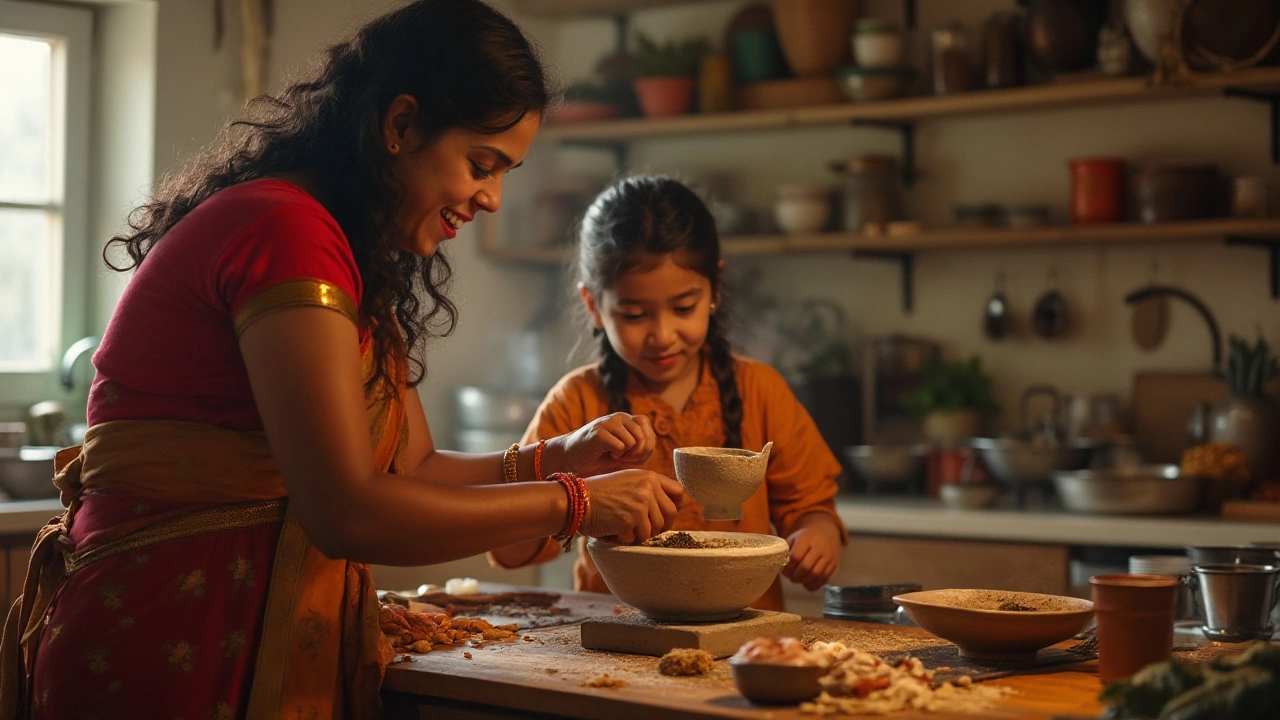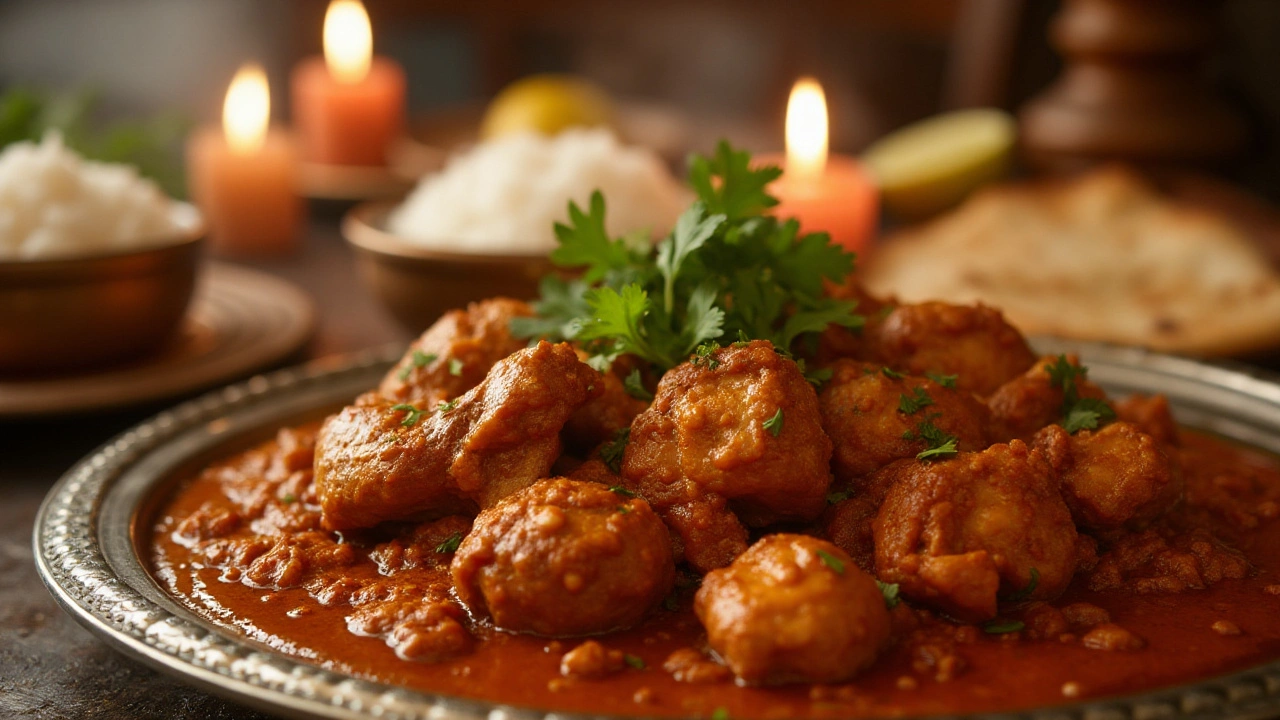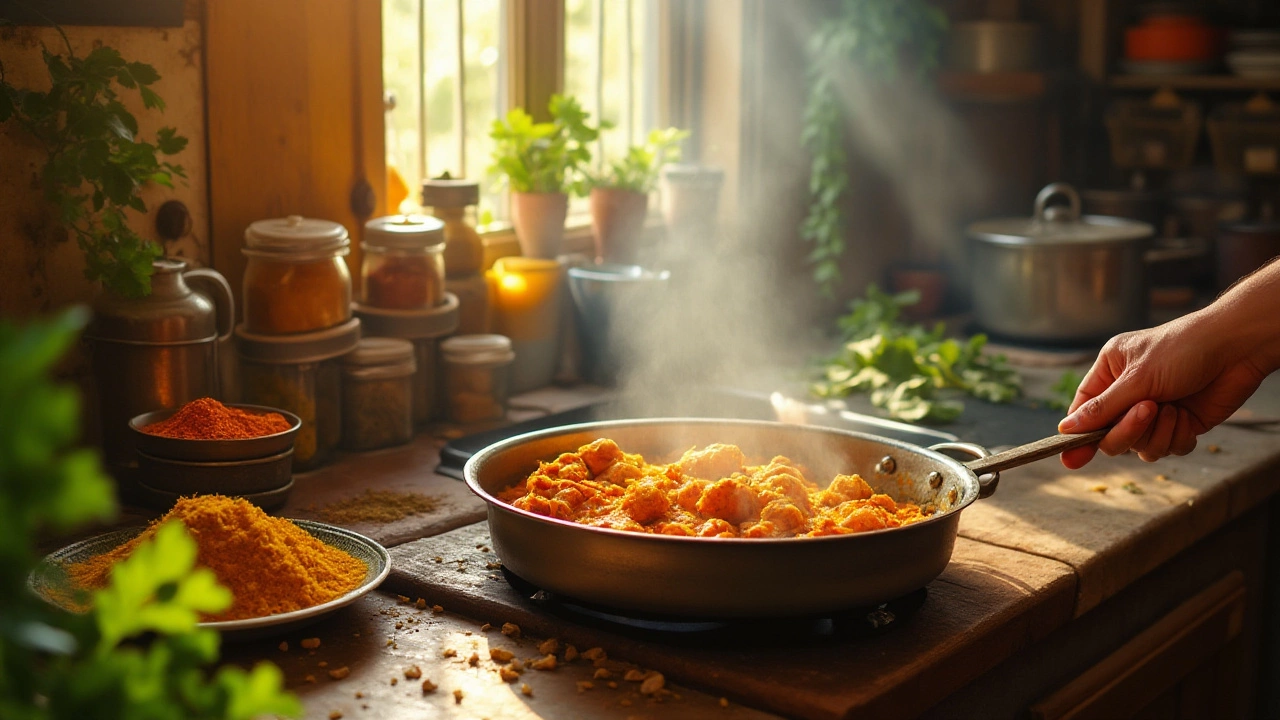Ah, the allure of a perfectly crafted chicken curry! Its rich flavors and aromatic spices can transport you straight to the bustling streets of India, where culinary traditions are steeped in history and culture. But what's the elusive secret to creating such a gastronomic masterpiece in your own kitchen?
The journey to a mouthwatering curry begins long before you even start cooking. It involves a careful selection of ingredients, a midas-like touch with spices, and a technique that balances tradition and innovation. This article peels back the layers of mystery surrounding the creation of an unforgettable chicken curry, revealing tips and nuances even a seasoned chef might find enlightening.
Whether you're a novice in the kitchen or a curry connoisseur looking to refine your skills, the secrets shared here promise to elevate your dish from mundane to magnificent, ensuring each bite leaves a lasting impression.
- Selecting the Right Chicken
- Spice Blends and Their Magic
- The Importance of Cooking Techniques
- Choosing Accompaniments Wisely
- Common Mistakes to Avoid
- Innovative Tips for the Perfect Finish
Selecting the Right Chicken
The essence of a chicken curry recipe that's bursting with flavor largely depends on choosing the right chicken. When it comes to this integral ingredient, not all chickens are created equal, and your choice can make a significant difference in the outcome of your dish. Opting for free-range or organic chicken is advisable, as these birds tend to have more robust flavors and firmer textures compared to their commercially-raised counterparts. This ensures that your chicken curry doesn’t just turn out delicious but also noticeably superior in quality. It’s important to consider the specific cut of chicken too. While some prefer thighs for their juiciness, others might lean towards breasts for their leaner nature. In fact, a blend of both might strike the perfect balance between taste and texture.
When sourcing your chicken, freshness is paramount. Fresh chicken, as opposed to those that have been sitting in a chiller for days, offers not just better taste but also cooks more evenly. Take a trip to your local farmer’s market or a trusted butcher who can often provide helpful advice about the freshest options available. But let’s not forget the value of cultural wisdom. According to renowned chef Madhur Jaffrey, “The quality of your base ingredient dictates the caliber of your curry. It's akin to painting on the finest canvas.”
Consider marination as a preliminary step in amplifying flavors. Even if a recipe doesn’t specify, a brief marinade with basic spices like turmeric, salt, and a bit of lime can dramatically enhance taste. This treatment allows the chicken to absorb flavors more efficiently during cooking. What’s more, avoiding excess water in your chicken is crucial. Excess moisture can lead to steaming rather than sautéing, which can dilute the rich flavors associated with classic curry. These nuances in handling and prepping the chicken, while often overlooked, hold the secret to achieving a remarkable depth of flavor in your dish, ultimately setting your homecooked meal apart from the rest.
If you’re truly on a quest for the perfect chicken curry recipe, knowing your bird, understanding its origin, and treating it with care are steps that cannot be emphasized enough. Crafting a memorable chicken curry is as much about technique and ingredients as it is about capturing the heart of authentic culinary expression.
Spice Blends and Their Magic
Spices are the heart and soul of any great chicken curry recipe. These tiny yet mighty ingredients can transport us across continents with just a single whiff, or evoke memories from our grandmother's kitchen. The art of blending spices is akin to a painter mixing colors to create a masterpiece; each spice brings its own unique flavor profile, aroma, and warmth, and when combined harmoniously, they elevate an ordinary dish into an extraordinary culinary experience.
At the core of an excellent chicken curry is the triumvirate of spices: coriander, cumin, and turmeric. Coriander seeds imbue a bright, citrusy undertone that balances the richness of the dish, while cumin seeds lend an earthy, warming aroma that grounds the flavors. Turmeric, with its vibrant golden hue, not only adds depth in color but also plays a part in a myriad of health benefits. Then, we have the often-overlooked but crucial players: cardamom, cloves, and cinnamon. Cardamom offers sweet floral notes, while cloves contribute a peppery pungency, and cinnamon brings in a subtle sweetness that rounds off the flavor spectrum perfectly.
"Spices speak to a language of love and comfort in every bite," says Madhur Jaffrey, an acclaimed food writer and authority on Indian cuisine.
Creating spice blends, or masalas, is a cherished practice passed down through generations. A typical garam masala blend might include a balance of black pepper, nutmeg, fennel, and even dried red chilies. But each family might boast its own secret formula, tailoring it to the palates and traditions unique to their household. The spices are gently roasted to unlock their essential oils before being ground to a fine powder. This process is delicate; too much heat and the spices can become bitter, too little and they may not release their full potency.
Customizing Your Spice Blend
Blending spices for chicken curry isn't a one-size-fits-all endeavor; it's about finding your own rhythm and preference. Some prefer their curry with more heat, adding extra chilies or fresh ginger, while others might focus on the sweet nuance by accentuating the use of cinnamon or cloves. It's a matter of personal taste and understanding the power each spice holds. Additionally, bay leaves, fenugreek seeds, and mustard seeds are often used to layer flavors. These can be adjusted depending on whether you desire a more herbal or earthy tone in your curry. According to culinary experts, fresh ground spices are always preferred over pre-ground versions, as they contain more volatile oils, which means more flavor and aroma.
To make the most out of your curry spices, proper storage is key. Spices should be kept in airtight containers in a cool, dark place, far from heat and light exposure, to preserve their potency and freshness. Properly handled, they can last up to two years, allowing you to experiment with your curry recipes and find the ideal mixture that resonates with your taste buds. Remember, the secret to crafting a memorable chicken curry lies in how well you play the orchestra of flavors that spices bring to your dish. It's about experimenting, trusting your instincts, and daring to go beyond the page to create something uniquely yours.

The Importance of Cooking Techniques
Crafting a memorable chicken curry recipe is an art that dances delicately between the mastery of spices and the finesse of cooking techniques. While many believe that the secret lies solely in the exotic spices characteristic of Indian cuisine, seasoned chefs will tell you that it is the method of cooking that truly elevates a dish. The techniques employed at various stages of the cooking process can influence the depth of flavor and the texture, resulting in a curry that's not just a meal, but an experience.
The first step in mastering curry-making is understanding the role of tempering. This method, known as "tadka" in Hindi, involves heating spices in oil to release their essential oils and enhance their flavors. This isn't just a casual splattering of spices; it requires careful attention to temperature and timing. Burnt spices can impart bitterness, while under-tempered spices may remain bland. An effective tadka acts as the soul of a curry, infusing it with a robust, aromatic presence that lingers on the palate.
The way you introduce the chicken into your curry pot also matters. Many experts recommend browning the chicken first, a process that caramelizes the protein and locks in the juices. This not only imparts a smoky flavor but also ensures the chicken curry recipe remains succulent. Some traditions suggest marinating the chicken with yogurt and spices beforehand, which helps in tenderizing and imparting a rich flavor profile from the get-go. This step can significantly elevate the taste, making it worth the extra effort.
A golden rule in the art of curry-making is patience in simmering. Let the curry bubble gently to allow the spices to marry harmoniously with the meat. In the bustling kitchens of India, cooks often let the curry simmer over a small fire for hours, occasionally stirring and tasting to perfect the seasoning. This gradual melding of flavors is where magic happens, providing a depth that hurried cooking cannot achieve. As chef Vivek Singh of the Cinnamon Club once said,
"Good curry, like a good story, can't be rushed."
Another crucial technique to consider is the balance between creaminess and spice. Mastery involves knowing when to add ingredients like coconut milk or cream to soften the heat of the spices without overshadowing them. A strategic addition can make a curry rich and luxurious, transforming what could be a simple dish into a culinary delight. This balance often calls for a good sense of taste and an intuitive feel for the ingredients—a skill seasoned with experience and experimentation.
And then, there’s the finishing touch, the garnish, which might seem minor but is pivotal to a complete dish. Some prefer fresh cilantro leaves for a punchy herbaceous twist, while others might drizzle a dash of lime juice for a tangy lift. Such details, though added at the end, should never be an afterthought; they are the final note in the symphony of flavors that a well-cooked chicken curry recipe offers.
Choosing Accompaniments Wisely
When it comes to pairing the right accompaniments with your chicken curry, it’s akin to choosing the perfect frame for a beautiful painting. Accompaniments not only enhance the flavor profile of your dish but also transform the entire dining experience. Let's start with the quintessential rice. While plain steamed rice is a traditional choice that highlights the robust flavors of your curry, consider the aromatic basmati rice, which adds its own subtle fragrance, complementing the spicy and savory notes of the dish. Adding a touch of saffron or a sprinkle of fried onions can elevate this simple side into a royal delight fit for a feast.
Next, consider bread accompaniments. Naan bread, with its fluffy texture, serves as an excellent vehicle for soaking up the luscious curry sauce. Garlic naan introduces an additional layer of flavor, integrating seamlessly with the subtle hints of garlic sometimes present in Indian curries. Roti, a whole wheat flatbread, offers a slightly healthier choice without sacrificing the soft and pliable texture necessary to scoop up tender pieces of chicken. A wise choice of bread can significantly enhance the sensory pleasure of a curry meal.
Incorporating vegetables can also make a difference. A side of sautéed spinach or roasted seasonal vegetables offers a wonderful balance against the rich and sometimes fatty components of a curry dish. For a touch of refreshing contrast, a cucumber raita — yogurt mixed with fresh cucumber and mint — provides a cooling effect, especially if you’ve opted for a particularly spicy chicken curry. This smooth accompaniment can ease the palates of those less accustomed to spicy flavors.
Don’t underestimate the power of chutneys. Mango chutney, with its sweet and tangy notes, can introduce an exciting contrast to savory chicken curry. Tamarind chutney, another favorite, introduces a tang that pairs beautifully with the savory and spicy elements of the curry. Including a selection of pickles can also provide that additional layer of complexity, transforming each bite into a delightful experience.
Occasionally, adding a drink to the mix can complement the entire meal wonderfully. A lassi, either sweet or salted, not only aids digestion but also cleanses the palate, making subsequent bites of curry even more flavorful. A simple glass of chilled water, while common, is understated as a fine companion to manage heat.
According to noted chef Madhur Jaffrey, "Accompaniments should not overshadow the curry, but they must hold their own like an excellent supporting cast enhances the lead actor." It’s important to remember, when crafting your culinary ensemble, to balance intensity and subtleness, spicy notes with cooling elements, ensuring a harmonious dining experience. Your choice of accompaniments can transform your chicken curry into not just a dish, but a symphony of tastes and textures.

Common Mistakes to Avoid
The quest to master a chicken curry recipe often trips many budding chefs into common pitfalls that can muddy the bright, bold flavors that a perfectly cooked curry should embody. One might imagine curry-making to be a simple toss of spices into a simmering pot, but it is, in fact, a rather delicate balancing act. A frequent mistake is misjudging the amount of spice – too little, and the dish tastes bland; too much, and it’s a firestorm that scorches the taste buds. Understanding the right proportions requires both a keen sense of smell and taste.
Another stumbling block comes from the misguided notion of cooking times. In the haste to bring the dish to the table, many cut corners, particularly with chicken – which leads to a gritty, overcooked disaster or a dangerously undercooked dish. It is vital to cook the chicken just long enough to soak in the flavors, but not so long that it struggles to find its place beneath an avalanche of sauce and spice.
Miscalculating the consistency of the curry is also a common error. An ideal curry has a silky, lush texture that clings gently to the chicken, prized in both appearance and taste. Achieving this requires careful attention to the amount of liquid. Too much, and it becomes a soup; too thick, and essential components struggle to meld. The key is to slowly simmer the curry, allowing it to steep to perfection.
A surprising misstep is ignoring the indispensability of fresh ingredients. Opting for pre-packaged or frozen alternatives to fresh spices and herbs might save time, but it comes at the cost of a curry's soul. Freshly ground spices release essential oils that sing to the senses, adding depth and complexity. The aroma of cardamom, the warmth of cumin, and the sweetness of clove bring the dish alive in a way that no prepared mix can replicate.
Culinary expert Madhur Jaffrey once observed, "The true essence of Indian cuisine lies in the freshness of its ingredients and the care with which they are handled."
Improperly balancing the heat with other flavors like sweetness or acidity can leave your curry tasting one-dimensional. Some chefs suggest adding a hint of sweetness using a dash of honey or sugar, which can accentuate and complement the piquancy of the spices. A squeeze of lime can lift the palate, ensuring the dish remains vibrant and lively to the very last bite.
Finally, there’s the timing of seasoning. Too often, salt is used as a late-stage solution in the hope it will fix a bland outcome. For a harmonious dish, seasoning should be a gentle segue throughout the cooking process. Sprinkling in phases allows flavors to develop interdependently, each step building on the previous one, fostering complex nuances that astound with every spoonful.
Innovative Tips for the Perfect Finish
Crafting the ultimate chicken curry doesn't stop at selecting spices and mastering cooking techniques. The final touches can make or break the dish, elevating it to the next level of taste and presentation. This is the stage where creativity can shine. Experimenting with a squeeze of citrus can enhance flavors by adding a bright, zesty note that contrasts with the richness of the curry. Whether it's lime or lemon, the acidity sharpens the taste and adds freshness.
Another secret weapon is a dollop of yogurt or cream swirled in just before serving. This not only adds creaminess but also gives a visually appealing marbled look to the curry sauce. These elements bring depth and balance to the dish, offsetting the heat of the spices with a subtle hint of coolness. You might find that some chefs also sprinkle a dash of garam masala or freshly chopped cilantro at the very end to give that burst of freshness.
Adding Textural Elements
Do not underestimate the power of textures. Adding roasted nuts, such as almonds or cashews, can bring a delightful crunch that surprises the palate. A scattering of these, slightly crushed and toasted to perfection, not only provides a rich, nutty flavor but also enhances the dish's complexity, making each bite varied and interesting. You could also consider using crispy fried shallots or onions. These provide an unexpected bite and a touch of sweetness that complements the flavors of the spices.
Incorporating Aromatics
Additional aromatics can also work wonders. Fresh herbs like mint and basil, added in moderation, can introduce an entirely new flavor dimension. These herbs have an invigorating aroma that pairs beautifully with the spices in your curry. They should be used sparingly, though, as their powerful flavors can easily overwhelm. An unusual yet effective choice is pandan leaf, known for its vanilla-like scent.
"When you start with great ingredients and finish with imaginative touches, you're not just cooking—you're creating art in a bowl," says culinary expert Kiran Jethwa.
For an extra punch, think about the table presentation. Using vibrant garnishes, such as red chili slices or a sprinkle of pomegranate seeds, turns the curry into an eye-catching centerpiece. This not only intrigues the diner but also shows the care and creativity that went into crafting the dish. Whether you are serving family on a weeknight or guests at a dinner party, these final touches promise to impress.
